Over the last five years, Google Classroom has emerged as a popular application which streamlines the distribution and grading of assignments. Every week Tech Edvocate readers send us emails looking for tips and tricks to unleash the app’s true potential. As such, we decided to compile all these questions and answers into one readily available article for our readers.
What is Google Classroom?
Google Classroom is a collaborative app, accessible on both the web or a mobile device, that provides an online platform to simplify and organize digital learning. It aims to improve interactions between educators and learners. It has four sections, each having unique features and functionalities:
- Google Classroom has a “Class Stream” section that enables educators to post crucial announcements for their students. Educators can post links, videos, documents, or other text messages here.

- The “Classwork” section allows educators to post assignments, quizzes, or share study material with students.

- The “People” section shows the teacher’s name and lists the students enrolled in the class. You can use this section to check if a particular student has turned in their assignment or email a student or guardian.

- Finally, the “Grades” section, which is only available for educators, offers an easy grading option for the submitted assignments.

Google Classroom creates a separate Drive folder providing a centralized location to store all digital materials of the Classroom. This feature helps organize various assignments, shared files, and other documents benefiting both educators and students. It certainly frees up a lot of your valuable time.
Google Classroom has numerous time-saving elements that improve classroom interactions. These are:
- One-click copy: You can easily make a copy of Google Doc for every student in your class. This feature eliminates the need to recreate new documents for every student.
- Assignment and grade management: This app provides an efficient way to customize the requirements of an assignment. You have the option to assign due dates or even chose to have no due date. The app also lets you effectively grade a submitted project and provide feedback to the students.
- Progress monitoring: The app lets you monitor the progress of every student in your class. You can comfortably check how many students have or have not turned in a particular assignment by clicking the assignment link. Alternatively, you could also go to the “People” section.
- Instant feedback: This feature lets you interact with individual students by commenting directly on their shared files. You can also provide feedback on their assignments by praising them or giving tips for improvement.
What is G Suite for Education?
G suite for education is a free Google service that brings together several of its products, enabling efficient interaction and collaboration between educators and learners. These apps provide students with the opportunity for creative thinking, all while helping them master learning objectives. You can use the application for free in your web browser.
Educators can use this service to prepare engaging digital content for a better learning experience while students can work together and complete assignments and group projects. Incorporating this service into the teaching and learning process makes remote learning seamless and practical. The core services include:
- Google Classroom: It is a digital classroom that allows educators to post and organize assignments, study materials, videos, and documents. It offers an online platform that facilitates interactive learning. Educators can grade the projects and provide feedback for improvement.

- Google Docs: It is a free web-based word processor. You can create and edit well-formatted documents with tables, images, and drawings. One can easily share Google Docs with anyone in your Classroom. It is an excellent tool for students as it lets them create documents at ease and facilitates sharing ideas with others. Teachers can use Google Docs to create worksheets and other engaging content.

- Google Sheets: It is a free web-based spreadsheet application for analyzing and organizing data. It is a useful tool for making charts, progress monitoring sheets, sign-up sheets, communication logs, and much more.

- Google Slides: It is an online presentation tool that lets you deliver your content in a well-formatted manner. Students can create presentations for seminars or group projects. Educators can also use this app to create slides, which provides a fantastic visual learning experience.
- Google Forms: It is a web-based survey and quiz tool. Teachers can use this tool to create surveys in formats like multiple choice or and True/False. They can also use this tool to quiz their students. You can access the submitted results through a spreadsheet.

- Google Drawings: It is a web-based graphic editor or diagramming tool. This tool allows you to edit and format images, flow charts, diagrams, etc. Students can use this tool to share their perspectives, which encourages them to think on their own. Educators can also create content that can help deliver instruction. The scribble tool also allows students to jot down lecture notes or questions.

How Do I Sign In to Google Classroom?
When logging into Google Classroom for the first time, follow these steps. The steps are the same for both educators and learners.
Step 1: Search for classroom.google.com on your web browser.

Sign in to the Classroom application by entering the email address that is associated with one of the following user account types:
- School account: It is also known as a G Suite for Education account set up by a recognized school. The email generally looks like [email protected]. If you are facing any issues with this email, you may contact your school’s IT administrator.
- Personal Google Account: This a personal email account set up by a student or guardian. Typically a home school would use a personal Gmail address. The email address should typically look like [email protected].
- G Suite account: It is a professional account set up by a company administrator. It looks like [email protected].
Step 2: After entering your email address, the website will prompt you to enter your password. Click ‘Next‘ after you have entered your password.

Step 3: A welcome message will greet you. It will also list your name and email address. Click Continue.

Step 4: A G Suite for Education account would require you to identify yourself as either a student or teacher. Personal Google accounts, however, will not have this option.

Step 5: If you are a student, click on the + sign in the right-hand corner of your screen and select Join class. Or, if you are an educator, click on Create Class. Your account setup is successful. You are now ready to use Google Classroom!

How Can Teachers Use Google Classroom?
Google classroom is an exceptionally flexible application. It has tons of useful features that can benefit educators. Google Classroom enables educators to:
Organize their classes better. With the help of other integrated Google services and tools such as Slides, Docs, and Drive, educators can effortlessly conduct and manage courses. For instance, they can assign due dates, which are then automatically added to the class calendar. Similarly, an educator can use Drive to store all relevant documents, files, and assignments centrally. They could also use Slides or Spreadsheets to create engaging educational content for a better learning experience.

Distribute and collect assignments, projects, and course materials. Educators can edit assignment topics and distribute them to several classes at once. They can also reuse these topics every year. Students with access to technology can significantly benefit from these features. With Google Classroom, educators do not need to waste time creating multiple physical copies of the same document. This feature also keeps students engaged in their studies.
Communicate with students about their classwork. Teachers can assign due dates or post reminders about assignment submissions. They can also check the progress of individual students and help them with their queries. This teaching method requires frequent and effective communication to build a stronger relationship between the educator and learner. The application also provides a quick option to provide feedback to the students.

Give timely feedback on assignments or assessments. With Google Forms tool’s help, educators can quiz their students on any course topic and grade them accordingly. Students can get instant feedback on their work to keep them motivated. Teachers can also use the private comment feature to correct mistakes or praise them.
How Does Google Manage Privacy and Student Data?
An educator should always be concerned with the learners’ data and privacy while choosing a digital application for their Classroom. An application might collect private data from learners, and an educator needs to ask questions about this. The company that created the product must be transparent about its data protection policies.
Google claims to prioritize data security and privacy for all G Suite for Education products. The company asserts that they collect data every time a student clicks a link, downloads a file, watches a video, or searches the web. The reason this data is collected is to make their services work better for the user. Google makes an effort to be as transparent as possible about their data and privacy policies. They make assurances that they only use the collected data for product and service development and is otherwise kept private.
However, stakeholders have expressed sincere doubts about Google’s capability to deliver their promises about user privacy and data protection. Google branding in various schools has also raised questions on trade-offs that have possibly enabled Google to build its brand.
Educators must realize that students or guardians may choose not to use Google products in school. The school administration must have an alternative plan for those who choose to opt-out. Schools must also obtain permission from parents or guardians before implementing any form of online learning. No administration can force a private digital learning platform on any student. Some parents may also be against the entire idea of digital learning and prefer the more traditional approach. Hence, educators should discuss all relevant information about online and remote learning with both students and their parents.
Irrespective of using Google Classroom, it is essential to understand its data privacy and security policy. Educators should teach data privacy laws and internet safety. One should teach students the dos and don’ts on the internet and warn them not to share private and sensitive information on the web. Students should also be aware of networking etiquette and follow the general norms while on the internet. Eductors may also encourage families to make sure their children learn the implications behind internet safety.
How Can Google Classroom be Used to Differentiate Instruction?
A formative assessment aids in each learner’s educational growth by keeping them motivated and providing additional support if needed. Numerous formative assessment applications have now added Google Classroom integration. Using tools like Google Forms, you can differentiate a student’s instruction and assist them accordingly. For instance, you can give a student a quick formative assessment to determine if they comprehend what has been taught. If not, you can reteach the material using alternative strategies. Consequently, you can provide them with private feedback or show support.

Google Classroom enables educators to edit and redesign assignments for a particular student or a group. One can personalize an assignment to help their students master the skill being taught. This feature helps students with specific needs or problems to understand and function alongside their classmates. The educator can choose to provide additional materials, notes, videos, or instructions with the assignments. They could also customize the due dates for various students depending on their ability to perform. Students with learning difficulties or language barriers benefit significantly from custom assignments. Educators can also routinely check on any student and help them with queries or questions.
Google Classroom lets educators pay attention to every student and help them individually. The option to comment and provide feedback privately makes differentiation efforts less conspicuous. Students feel equally special, and the thought of being left out doesn’t cross their minds.

Being on the internet or not, assisting every individual student will always require a creative approach. It ultimately depends on the educator and how he or she wants to express themselves to the class. One should be willing to support each student’s needs while ensuring that others don’t feel left out. Luckily enough, the web offers tons of excellent tips and tricks to provide a better learning experience.
How Can Google Classroom Make Learning Fun and Interactive?
Educators can use the Classroom application to make digital learning a fun and engaging task. They can always use apps like Slides and Drawing to create impressive visual learning materials. Also, in addition to using integrated tools, teachers can try to randomize the course materials. One can try to teach a topic using videos, images, or step-by-step voice instructions. This method reduces the monotonous text-based study materials that take away the charm from learning. With so many customizable features, educators can make sure students receive their education in a way that fits their learning style.

If an interactive hub is what you want for your students, you should use the ‘Stream’ section in the Classroom application. The ‘Stream’ section is the first page your students see when they log into their account. It is essentially a feed where you can post important announcements, assignments, and other course-related materials. This section creates an open space for both students and educators to interact share ideas. I would personally recommend educators to use Screencastify, which allows you to present files and documents with an audio clip of your voice explaining the same. This feature lets students get personally attached to their education.
Learners now have the platform to participate in group discussions and have their voices read by the entire class.

Can I Add an Assignment to Google Classroom Without Adding it to the Stream?
The ‘Stream’ is a community hub, which lets you post announcements to keep learners informed. However, many educators seem to dislike the randomness of Google Classroom’s ‘Stream’ section. Apart from important messages and posts, duplicate notifications of updated classwork appear in abundance. This issue makes the ‘Stream’ incoherent and confusing. If you only want conversations to appear in ‘Stream,’ you can disable automatic notifications of posts on the ‘Classwork’ page. Learners can always check their assignments by clicking the ‘Classwork’ tab. This technique will make your community hub take up less space.
You can manually adjust your settings to disable default notifications from the ‘Classwork’ page or hide them entirely. You can also have a collapsed or expanded view of notifications on your ‘Stream’ page. Educators can customize what they want on their main community page to avoid incoherence. Follow these steps to change the settings:
- Go to classroom.google.com, and you will find a menu with your classes.

- Select the class that requires a change.

- Click on the Settings button (top right corner, third icon from the left) on the Stream Page and scroll down to General settings. There is a drop-down option under “Classwork on the stream.” You can manage your notifications there.

- You can select “Show attachments and details” if you want a detailed post about the assignment you created, including all instructions and attachments.
- You can select “Show condensed notifications” if you want a short condensed version of the assignment post on your Stream. This option will show only the title of the assignment. It is also the default option.
- You can select “Hide notifications” if you want to remove all automatic posts about your assignments from the Stream. It entirely depends on the educator and how they want their Google Classroom to appear.
5. After making your selection, save your changes by clicking “Save” in the right-hand corner.
Can I Place A Worksheet in Google Classroom?
You can also rephrase this question as, “How do I put a PDF inside Google Classroom so my learners can write on top of it.” Educators should always keep in mind that digitalizing a paper worksheet is often challenging and tedious. Plus, it usually isn’t worth the hard work either.
Be sure to ask yourself these questions before you attempt to digitalize your worksheet:
- Will this worksheet help students learn?
- Is this worksheet better than hands-on learning?
- Is this worksheet better than a group discussion?
- Is this worksheet a better job of engaging learners in new ways? —This is the most reasonable utilization of technology! Its purpose is not to save paper but modernize old ideas. Technology provides us with an opportunity to create learning environments that weren’t possible before.
- Instead, can I create a Google Doc with similar information to support the same learning objective? It is way easier to insert an equivalent Google Doc.
However, If you still want to upload a worksheet, follow these steps:
- Scan the document using a scanner. Compile the photos into a PDF and save it on your computer.
- To add the pdf to your Drive, go to drive.google.com. Click on the “New” button (+ sign in the top left corner).

- Click “File Upload.”

- A new window which includes your computer files will appear. Navigate to the PDF file that you want to upload and click “Open.” The PDF will start uploading.

- Now sign in to your Google Classroom account. You can add your newly uploaded PDF document as a stream post or while generating a new assignment. Click “Add,” then choose “Google Drive,” and select your document.

How Do I Give Parents Access to Google Classroom?
Educators can send parents emails, keeping them updated about their children’s digital learning. However, you can only add parents to the Classroom using a G Suite for Education account. Personal Google accounts cannot benefit from this feature. Educators should have no trouble whatsoever since most schools these days use G Suite versions anyway. It is always great to have parents involved in their children’s education.
Educators need to invite parents to Google Classroom by adding their email under their child’s name. You can send invites from the ‘People’ tab, which should be accepted by the receiver. The invited parents receive summaries of their child’s progress in the Form of an automated email. Parents can choose how often they want to receive the summaries (daily or weekly) and can also unsubscribe at any time.
The email summaries contain information about the following:
- Unsubmitted work or assignments.
- Due dates of assigned work. Daily emails contain due dates that are either today or tomorrow. Weekly emails contain due dates in the upcoming week.
- Class activities like essential announcements, assignments, and questions that educators recently posted.
Google Classroom has email summaries turned off by default. Educators should note that parents don’t have access to any of the sections of the Classroom. They also cannot view posts on your class stream. As such, guardians cannot see their child’s grades. Therefore, educators have to communicate with parents using other reliable methods like personal email. They should also discuss this issue with parents before inviting them to the Classroom.
You can turn on “Guardian summaries” by navigating to the Settings page. Then scroll down to General settings.

Click the grey button to the right of where it says, “Guardian summaries.” The button will turn green, indicating that the feature is on.
You can also click “See example” underneath “Guardian summaries” for more information on this topic.

How Do I Use Slides Without Using Google Classroom?
Yes, all educators with a G Suite account or Gmail account can use all Google applications for free. Google Slides is one of the free apps that you can access from Google Classroom as well. To launch the app, open your Chrome browser and click the Google Apps icon. The icon has a grid of nine grey dots (also known as the waffle icon). Once you click the icon, the Google apps menu will appear. You can select Google Slides or any other app that you want to use. For Slides, a new slideshow document would be available. You can use it to create a well-formatted presentation for your Classroom.
It will look like this:

If you want to share your presentation or give someone access to Slides, follow these steps. First, open a new Slides document, and then share it from the ‘File’ tab.

Alternatively, you can click the yellow “Share” icon in the top right corner. Click on “Copy link” in the “Get link” section. A link to the slideshow will automatically be copied.

You can share this link via email or even post it on your Stream page. When someone clicks the link, they need to request permission to open it. Consequently, you will receive a request email, which you may choose to accept or deny. Also, always be sure to check who requested the permission. The shared Slides file won’t require a Gmail account for someone to edit it.
The students who want to share their presentation files can either email a copy of the file or share the link to their work. They can follow the same steps to copy the link to their document. They will also have an option to enter your email address directly. You can find the shared document on your Drive in the “Shared with me” section.
What Can I Do With Google Classroom?
So this probably is the most critical question to ask. Why should you choose Google Classroom? And what’s in it for you? To answer your questions, you first need to analyze the pros and cons of a physical classroom. Although a traditional classroom seems to have a more lively student-teacher interaction, it may not be entirely accurate. However, in such a situation, it is often challenging to manage and organize assignments, grades, or attendance logs.
On the other hand, Google Classroom is a digital learning platform that allows you to handle and streamline how you deal with each student’s classwork. You can also set up a Classroom account for free in only a few minutes. The reasons which make Google Classroom a big deal are:
- Add announcements and course content: The Classroom app provides you with a community hub, called a Stream, to post information or share course-related messages. You can also add study materials, like documents, slides, etc., or even create discussion boards for interactive learning. Learners will be able to see these announcements whenever they log in to the Google Classroom app. Plus, all the uploaded files, documents, images, videos, etc., are neatly organized in a separate Google Drive associated with the Classroom. Yes, it is that simple.

- Teachers can quickly add assignments or other coursework for students. The assignments will have due dates, and you can promptly grade them. Educators can also choose to customize the projects or alter due dates for students with learning disabilties. The deadlines automatically get updated on the Calander app to provide timely notifications to the students. To create an assignment, you need to go to the “Classwork” section.

- Grade an assignment: You can effectively grade the assignments that your students turned in. There is also an added feature of private feedback, which you can use to praise a student or help them correct their mistakes. Once you finish grading, you can send the assignments back to your students. Throughout the semester, the grades will be neatly organized in a grade book in the “Grades” tab. This feature enables you to conduct paper-free grading!

- Manage learners: You can always choose whether you want your learners to post, comment, and share files. This option lets you maintain order on your stream page. Interactive learning is essential, but the unmonitored flow of opinions may result in chaos. You can choose the option “Students can post or comment” to let learners freely voice their opinions. The “Students can only comment” option allows learners only to comment on the posts that you make. Lastly, you may select the “Teachers can post or comment” option to restrict students from abusing their privilege. This feature lets you create a safe and orderly environment for digital learning.

What Can’t I Do With Google Classroom?
Although the Google Classroom application has emerged as one of the best online learning platforms where teachers can quickly post assignments, messages, grades, or share online resources. Certain features in the app are not so great. Here is the list of things the Classroom app does not have:
- A chatbox: The app only has a standard Stream section to post your messages or assignments. However, this feature doesn’t address the need for communication between educators and learners. There is no chat function to enable you to communicate with your students in real time. You either have to make use of the public Stream section or send private emails to your students. As a solution, you can use Google Meet or Hangouts for live video or audio communication.
- A test or quiz app: Although there are numerous ways to create quizzes for your students in Google Classroom app, it does not have a stand-alone quiz tool. You can always make use of integrated apps like Google Forms to add test questions for which you may choose to receive a short answer from your students or provide them with multiple choices. I would recommend using external applications to create quizzes and then share the link with your students.

- A discussion forum: Google classroom allows you to make announcement posts on your Stream and let learners comment on them. However, this does not allow you to interact with your students at an optimal level. When multiple students all comment on the same post, the thread becomes exceptionally long. This often will create difficulties for you as an educator as you will struggle to sort out and organize the comments to facilitate a useful discussion. Also, students cannot format the messages they send, meaning all messages will have the same color, font, and size. While there is the option for a discussion board, it is not as optimized as those in other learning websites.

What is the Most Efficient Way to Set Up Google Classroom?
Google Classroom is a beautiful digital learning application that streamlines web-based learning while also making it fun and engaging. It offers a straightforward account set up process for educators. You can follow these steps to set up your educator account:
1. Sign up
Go to classroom.google.com and then sign in using your G Suite for Education account. You can also use your Gmail address, but you might have difficulties inviting a large number of students. A personal Google account would require you to invite each learner individually.
2. Create your first class
Click on the “+” button on the top right corner of the screen to create your first class. Choose the “Create a class” option when prompted. Now fill in all the relevant information and type in a name for your class. Once you are happy with everything, click “Create.”

3. Invite learners to your class
Once you have created your digital Classroom, you can invite your students to the class. Go to the “People” section, and copy the unique code under the “Students” tab. You can share this code with your students, who will need to enter it while logging into the Classroom application. Alternatively, you can invite your learners by entering their email addresses. As an educator, you should keep in mind that the invited students must have a personal Google account or a G Suite for Education account to log into the class.

Learners who want to log into Google Classroom using the unique code need to visit classroom.google.com. They can click on “Join Class” and type in the unique code to enter their class successfully. This method also benefits the educators without a G Suite for Education account, as they don’t have to type in every student’s email manually.
Your Digital Classroom is now live! You may follow these steps to make the most out of your Classroom:
- To create an assignment or post your first announcement to the Stream, go to the “Classwork” section. Then click on the “+ Create” button and enter the required information to create your post. When making assignments, be sure to assign numbers to them so that learners can know which came first. Numbering is necessary because you cannot reorder your posts once they are on Stream. However, you have the option to separate your assignments from other posts and move them to the top. You can also re-edit your assigned tasks to optimize them for a better learning experience. After you have posted a project, you can click on the title to check student submissions.

- You can add course-related resources such as videos, presentations, worksheets, links, etc. either to your Stream or Classwork section. You can directly upload your content from your computer or add them from your Google Drive folder. Adding creative resources instead of regular articles or essays can help you make learning a fun and engaging experience.
- Educators can use Google Classroom’s shared drive folder to organize all course-related documents. This Drive folder is created automatically when you first make your Classroom. You can access this folder through the “Classwork” section, where you will find the “Class Drive folder.” All submitted assignments and projects are routinely added to this folder. This feature lets an educator manage tons of documents and files in a neat and organized manner.

Does Google Classroom Harvest or Collect My Child’s Data?
Google’s strict data privacy policies forbid them from tracking user data through the Google Classroom application. However, it should be noted that most apps associated with G Suite for Education do collect learner data. For instance, if a school opts for additional google services, the integrated apps collect user data.
Parents should know that if their child uses their personal Gmail account to log in to Google Classroom, data like the sites they visit, videos they watch, or their location are regularly collected. However, it is also necessary to know that Google offers complete transparency over its data collection policies and states that it is only utilized for app improvement.
Guardians should also be aware of another risk involving data privacy, which is third party involvement. Although Google never sells user data to partners or other websites, third parties often target individuals through ad-on applications to collect their data.
Educators should make sure that parents know about these data privacy issues and obtain permission before implementing an online learning platform like Google Classroom. Educators and parents should also teach learners to be responsible digital citizens and understand online etiquette and internet safety. Learners should always refrain from sharing personal or sensitive information on the web.

What Safety Settings Can I Enable on My Child’s Google Account?
Privacy settings can be changed on the Google Account page if your child uses a personal Gmail account for Google Classroom. If he or she uses a school account, you can contact the school administration regarding the settings you can change. However, keep in mind that Google Classroom requires certain information to stay public, such as your child’s name. The following settings might help you get rid of your internet safety concerns:
- The Personal Information page lets you choose what information you want to be public. You can customize this setting to allow only relevant information to be visible.
- The Data & Personalization page lets you take a Privacy Checkup and then provides you with a step-by-step guide on what privacy settings are the best for you. You can also visit ‘Activity controls’ to see the data Google collects from you. You can ‘pause’ an activity to stop Google from tracking it.

- The People & Sharing page lets you update and display your contact information or see what information you share with Google.
You may download the Google Family Link for Parents app from Google Play Store. This free application offers parental control options to monitor your child’s internet activity. Applications like this ease parent’s concerns while also letting kids have fun with technology. Here are some of the fantastic features the app provides:
- Manage apps your child can access
- Supervise screen time
- Set daily time limits
- Get activity reports
- Approve or deny the installation of apps
- Find your child’s location
- Create a family group of up to 6 people

How Can I Prevent Students from Using Google Classroom to Cheat or Cyberbully?
You should know that there is no option in the Google Classroom application to prevent learners from accessing other web content, such as Wikipedia or YouTube. Students can also view messages or comments that their classmates make on the Stream and reply to them. However, the submitted assignments are generally sent straight to the educator and can be kept private from other students. There is also a Quiz Lock feature that prevents students from visiting other websites during an ongoing test.
Cyberbullying, unfortunately, is indeed possible for learners to practice. Kids often cyberbully their classmates by commenting on their posts or using Google Meet or Google Hangouts. Chatting sessions between students during course-related discussions can often be a distraction. Victims have also reported cyberbully on group projects or shared Google Docs. This happens because a lot of students believe that no one would notice them there.
Your child can choose to turn off Hangouts or remove people from a shared file if he or she gets distracted by the constant chatting. To accomplish this, click “Share” and go to the ‘Advanced options.’ Then click the ‘X’ button next to the names of the people you want to remove. Teachers can turn off posts and comments of the students if they think they are abusing their privilege to cyberbully others.

There is no feature to prevent learners from engaging in inappropriate activities like cyberbullying. The best way would be for teachers and parents to talk to the learners about internet safety and the dos and don’ts on the web. They should teach them to be responsible digital citizens and tell them about the implications of negative behaviors. It would be best to remind them that their access to technology can always be revoked if caught abusing their privilege. Google Classroom is an application that tries to make the learning experience fun and beneficial. One should not misuse the features that this application provides.

What are the Most Popular Features and Functionalities of Google Classroom?
Assignments: Teachers can create and assign classwork to individual students or groups by adding online resources such as YouTube videos, Google Images, blog posts, or uploading PDFs directly from their computer. The assignments may have deadlines, which get automatically updated on the class calendar. Educators also have the option to re-edit classwork to optimize it further.

Customizable Grading System: Educators can quickly grade submitted classwork around a grading system or create a grade category. They can choose one of the following methods to provide students with their grades:
- Total Points Grading: Total points earned by learners is divided by the maximum points.
- Weighted by Category Grading: Grade categories are first assigned a weight. Then the average score of each category is calculated and multiplied with the grade weight. This action will give the overall grade out of 100%.
- No Overall Grade: Educators can choose not to grade an assignment.
Virtual Discussions: Educators can create discussion boards on the Stream to let learners voice their opinions freely. Learners can also choose to hold discussions on Google Docs, and teachers can provide feedback. Group discussions ensure that everyone is on the same page and keeps learning fun and engaging. Educators also have the option to mute specific individuals from commenting or making new posts on the Stream.
Announcements: Educators can quickly post quick announcements to update the students about classwork, projects, deadlines, etc. These announcements are mere messages that help learners stay on the same page with the rest of the class. Learners can also comment on announcements, but this is dependent on whether or not the educator has that option available.

Live Classes: Google has recently offered a service that allows educators to facilitate real-time video classes using Google Meet. Teachers can add up to 250 participants to the call and live-stream the session to another 1,000,000 viewers. The service has an added feature of recording the session for the learners who could not attend the class. Live classes provide an opportunity for students to learn a course-topic and clear up doubts through an open discussion among their classmates. These classes make the learning process enjoyable and straightforward.
How Does Google Classroom Help Teachers Personalize, Individualize, and Differentiate Instruction?
Google Classroom has many unique features that allow educators to cater to the specific needs of learners. You can do this in three ways:
Based on who the learners are
The application lets teachers create learning activities while keeping in mind a student’s proficiency in that subject. They can optimize coursework if a student struggles to keep up with the rest of the class. Teachers can also provide more challenging assignments for advanced students. Such variation in the classwork enables all students to be on the same page.
Educators can differentiate instruction for students with learning difficulties and offer them additional support. They can provide the learners with resources like presentations, worksheets, videos, graphical contents, or receive shortened assignments or extended due dates to keep them engaged in their work.
For students capable of completing more rigorous tasks, educators can optimize their assignments with increased requirements and criteria. They can also choose not to provide task resources, which will motivate them to do their own research. As you can see, the possibilities are endless. Despite requiring different education standards for different students, educators can develop the perfect assignment to meet those standards.
Based on how learners learn
The best teaching method for your students may vary from person to person. While some may enjoy learning from reading a textbook, others might want a more creative approach like presentations. With Google Classroom, you can easily upload documents, slides, videos, or other similar resources to cater to every learners’ needs.
Educators should understand that each student has a unique personality and set of abilities. Educators must teach using creative methods to bring the most out of their students. There may be learners who despise the traditional pen-paper teaching style and want to learn through visual presentations. Google Classroom has several useful integrated tools that help you achieve this goal. You can upload concept maps, images, diagrams, animations, or even include songs and podcasts for auditory learners. Similarly, kinesthetic learners can be offered virtual field trips, interactive games, etc.

Based on how learners engage with the educator
As I said, every learner has a unique set of abilities that make them stand out. They may want to express their thoughts in their own way. Google Classroom respects this individuality and allows students to submit their coursework in any format, based on their talent and interests.
Some students may enjoy working with audio files and can submit assignments by recording songs, podcasts, etc., while others may want to work on a video of them explaining the content. Similarly, some students may also prefer the standard text-based method matched with interactive images to make their point. Surveys have shown that many learners these days tend to make presentations for their classwork using free tools like Google Slides. Lastly, Google Sheets is another free tool that may be useful to kids who are good with numbers.
There are tools and options for every student to express their thoughts. You just need to be a bit creative to find what suits you.

Can Administrators Use Google Classroom Learning Analytics?
Administrators can access the ‘Highlights’ report, which lists App Usage Activity for Google Classroom, Google+, Google Drive, Gmail, and Google Calendar. Admins can view this list using an administrator account only. The report lets you analyze the in-depth usage of Google services and how they have benefited your educators and students. The available metrics are:
- Weekly active users
- The number of active classes in the last 14 days
- The number of courses created
- The number of posts created by educators and learners
- For individual users, the number of classes and posts created, and the last active time
What Are the Most Efficient Ways to Use the ‘Ask a Question’ feature in Google Classroom?
Exit Tickets: Before the class ends, educators can ask the students a quick question about the lesson. The question will appear on the Stream page of Google Classroom as soon as the learners log in. Your question can be multiple choices or short responses. Exit tickets often help sort the learner’s doubts.
Wait Time: Google Classroom has a feature that displays the students who have answered the questions you posted. A list like this can help educators to proceed at a comfortable pace for all students. They also get the opportunity to understand the strengths of their students better. Instead of asking each learner if they have responded to the question, teachers can quickly view the real-time updated list.
Share a Resource: The learners can share relevant resources like documents, images, or citations to back their responses. They can upload files or share links by clicking on the “Add” button. This option also encourages the students to research the topics that they are learning.

Multiple Choice Questions and Polls: Google Classroom offers educators the ability to create multiple choice questions and polls for their class. This feature is beneficial for educators who want to receive feedback on course work, as it is quick to set up the poll, and you can get your answers instantaneously. For instance, if you want to know what topics your class would be interested in studying, you can create a poll. Likewise, students can choose one of the many choices available to them. You can also choose to keep the anonymity of the poll result by unchecking the “Students can see class summary” (underneath the “Topic”) option.

Ask Learners to Ask Questions: Educators can ask learners to answer their questions or develop their own questions. It encourages students to think out of the box and improves their higher-order thinking skills.
How Does Google Classroom Improve the Teaching and Learning Process?
Google Classroom is a big time-saver: Google Classroom provides a centralized Drive for all your files, allowing you to place all your attention on more important things. Also, all the stored files are neatly organized to avoid confusion. You can grade assignments quicker on the digital application, as it doesn’t contain the hassles of pen-paper assessments. The digital grade book also saves you valuable time and effort.
Increased educator-learner engagement levels: Google Classroom offers tons of audio-visual tools, educational apps, and technical support to help educators create engaging lessons for their students. The platform allows you to develop assignments, post entertaining YouTube videos, upload an eye-catching presentation, or even include an interactive online game. Technology-driven students of this era benefit significantly from Google Classroom.

Makes teaching more focused and organized: Since all submitted assignments are recorded and stored, educators can quickly check whether students have submitted their classwork. You can access this information from both a desktop or mobile device by clicking on the corresponding tabs. This info also allows you to grade your students effectively, based on the work and time they put in. Educators may find viewing submitted work to be an easy process, as all the files are stored in the shared Google Drive folder, which is just a click away.

Learner-educator communication and collaboration is made easy: The application makes learner and educator interaction easier. Teachers can schedule their posts or post them directly to the Google Classroom Stream. These messages can be viewed by learners whenever they log in to their Classroom account. Integrated services like Google Meet and Hangouts also allow educators and learners to stay in touch through virtual communication. Video conferencing, Q&A sessions, and live classes are a few features that improve student-teacher interaction.
How Do I Attach Files or Add Links to Assignments in Google Classroom?
Educators can link documents, PDFs, YouTube videos, drive files, or websites using the Google Classroom app. They can also share and distribute learning activities, projects, and course-related content.
Here’s how you can do it:
- Select the Classroom you want to work in
- Click on the (+) button on the bottom-right corner of your screen
- Choose the ‘Create assignment’ option
- On the assignment creation pop-up, enter the title, instructions, topic, and deadline
- Choose the type of attachment you would want to include
- Click ‘Assign’

The attachment option is excellent for adding online resources or the files on your desktop. Attaching files created from integrated tools like Google Docs, Google Sheets, etc., is a pretty straightforward process. This feature saves a lot of time and effort.
Educators can choose how students interact with the files you upload on Google Drive. The following options will in available next to every uploaded file in the Form of a pull-down menu:
(a) students can view the file – learners will be allowed to read the file but cannot edit it.
(b) students can edit the file – learners will be allowed to read and edit the file freely.
(c) make a copy for each student – each learner will get an editable copy of the file. Each file will automatically have the learner’s name on the title. The edited copies will then appear in your Google Drive underneath the ‘Classroom’ folder.

You can also use the attachment feature to share answer templates that students should follow while completing their assignments.
Can I Share Assignments with Multiple Classes in Google Docs?
Suppose you have several classes accessing the same material. In that case, you can post the same resources or assignments to numerous classrooms at once through Google Classroom. All the learners will receive the same assignments at the same time, thereby effectively saving time.
To do this, click the pull-down menu on the top-left corner of the screen in the assignment creation pop-up message. It displays the current class you are accessing by default. Select the class (or multiple classes) you want to post the assignment to by clicking on the downward-pointing arrow next to the current class name. When you post the assignment, it will appear in all the Classrooms you have previously selected at the same time.

Can I Differentiate Assignments to Individual Students?
You can also assign different assignments and hand out additional resources to learners based on their ability level.
In the pull-down menu of the assignment creation pop-up, you will find your students’ names from a specific class listed. By default, ‘All Students’ will be selected. Click on the downward-pointing button next to it and select the name(s) of the student(s). Once you post the assignment, only those specific students will receive it.

Using the steps above, you can assign a more challenging assignment to higher-level students, a modified one for struggling students, or even make up an assignment for one specific student. The tasks can be differentiated with ease.
Similarly, you can post questions or assignments to a specific group of learners without the hassle of having to confuse the other learners with posts that are not intended for them.

How Can I Use Google Calendar Integration with Google Classroom?
When you create or join a class, a calendar pertaining to that class is added to your Google Calendar. Any appointments, video conferences, deadlines for assignments, or dates for exams can be updated through this Calendar. All changes will, by default, get updated on your learners’ calendars. This way, Google Calendar’s integration with Classroom makes it easy for you and your learners to stay organized.
How Do I Open Google Calendar in Google Classroom?
Select a Classroom > Click on the ‘About’ tab > Click on ‘Google Calendar’
This Calendar can be shared with your learners‘ guardians to allow them to make appointments and keep up with what is going on in class.
Here is how you do it:
- Place your cursor over the Calendar you want to share from under ‘My Calendars’ in your Google Calendar. Then click the three dots beside the calendar name.

- Click ‘Settings and sharing.’

- Now scroll down to the “Access Permissions” section, and check the box “Make available to public.”

- Click on ‘Get shareable link’ right below.
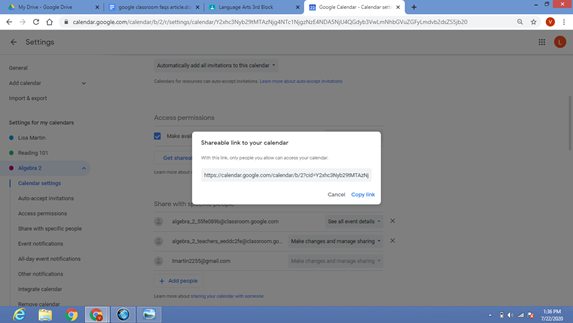
- You can then copy the link to share it with the parents through their social networking profiles or emails.
How Do I Archive a Room in Google Classroom?
If you complete a class and want to remove it from your home screen but don’t want to lose access to the shared assignments learner progress, you have an alternative. Google Classroom allows you to ‘archive the Class’ so that you can reuse those posts again.
Here is how you do it:
a. To archive a class
- Open the Google Classroom home page.

- Click the three-dots button located in the upper right corner of the class you want to archive and choose ‘Archive’ from the next menu.
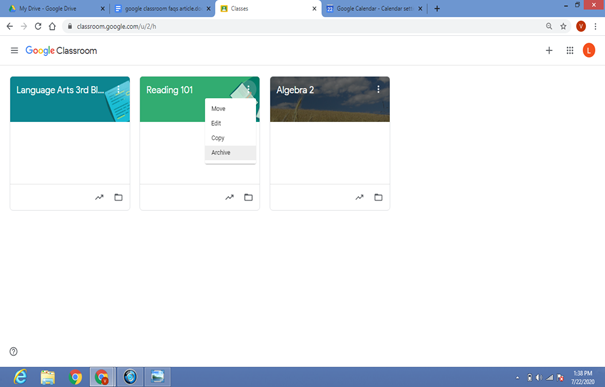
- Click ‘Archive’ again once the confirmation pop-up message appears
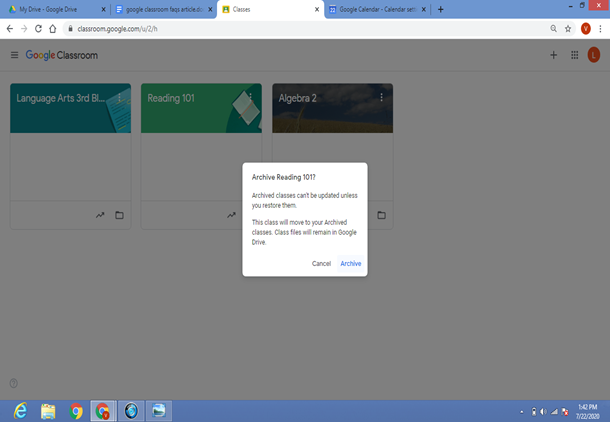
If you want to make an archived class active again, follow the steps below:
b. To unarchive a class
- Open the Google Classroom homepage and click the menu button in the top left corner of your screen.
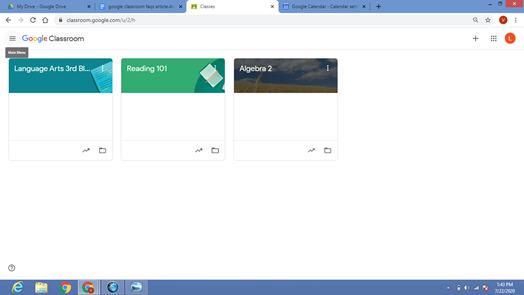
- Scroll down and click ‘Archived classes.’
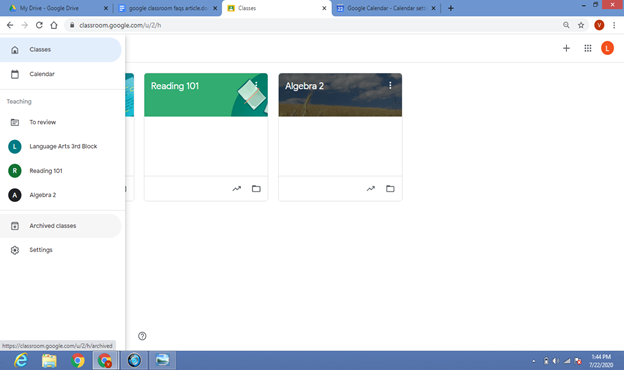
- Click on the ellipsis (three-dots) button located in the upper-right corner of the tile of the class you want to restore, and select ‘Restore’ from the drop-down menu.
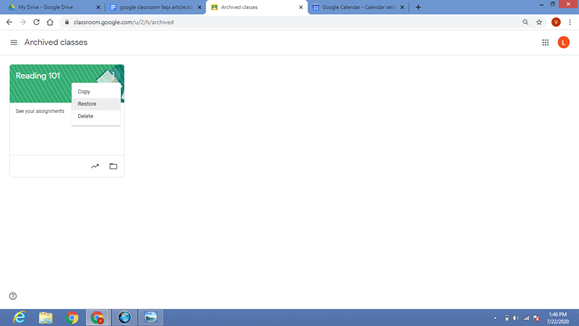
- Click ‘Restore’ again once the confirmation message pops up.
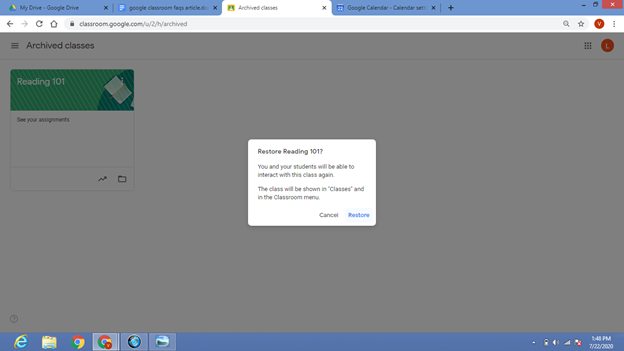
How Do I Reuse Old Posts and Assignments in Google Classroom?
If you want to share an old post with a new group of students or want your students to repeat exercises or review the content for a second time, Google Classroom allows you to do so.
Educators can reuse posts from one class in a different class. They can also reuse posts from archived classrooms.
You can follow these steps to do this:
- First, select a Classroom and go to the “Classwork” tab.
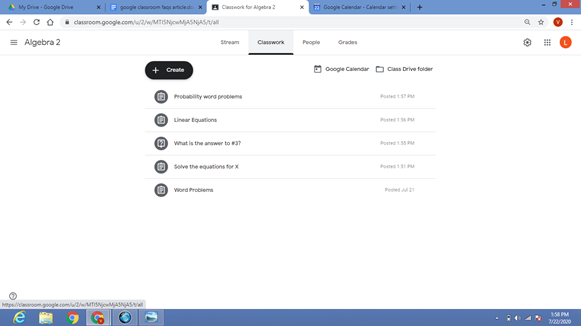
- Click the (+) Create button on your screen and scroll down to select ‘Reuse post.’
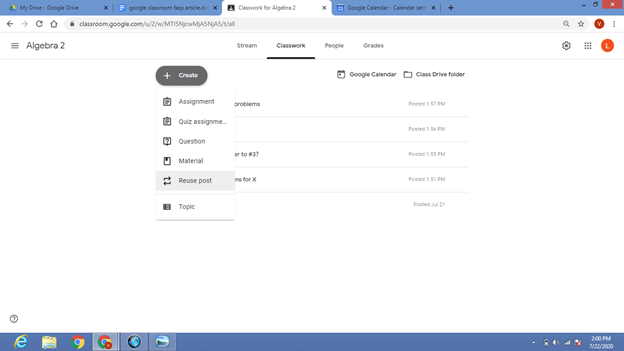
- The pop-up will list your classes, including the archived ones. Select the class you want to reuse the post from.
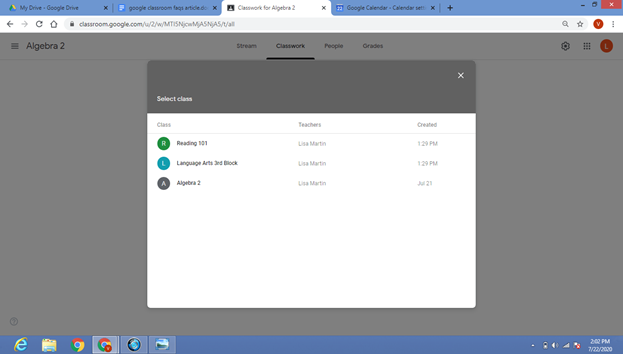
- The posts you previously assigned to the class will appear. You can choose the one that you want to repost.
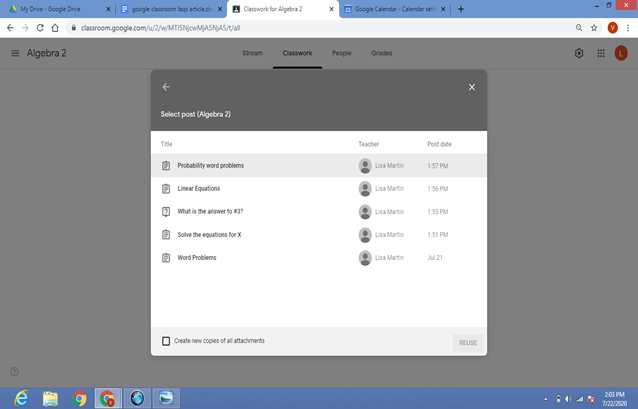
- If the post has attachments, check the box at the bottom-left corner that says ‘Create new copies of all attachments’ and then click ‘Reuse.’
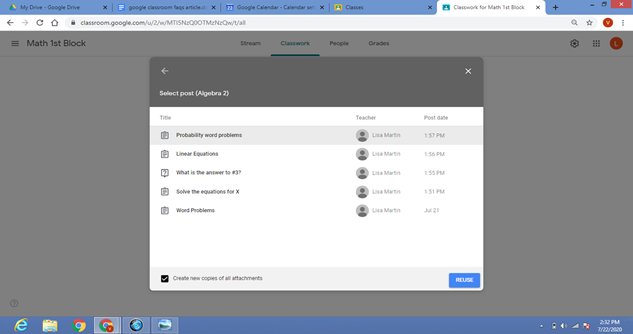
- The assignment creation pop-up appears; make changes if needed, and then press ‘Assign.’
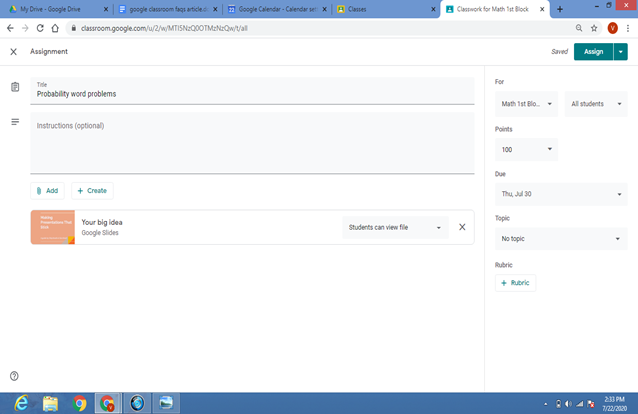
How Do I Schedule Posts and Assignments in Google Classroom?
In case you have several assignments ready to be allotted but do not want to post them all at the same time, you can schedule your posts so they can be posted on the day and time of your choosing. Once you set it, Google Classroom will automatically post it for you.
Here is how you do it:
- Create your post or assignment, and then in the top right-hand corner where it says ‘Assign,’ click the downward arrow and select ‘Schedule.’
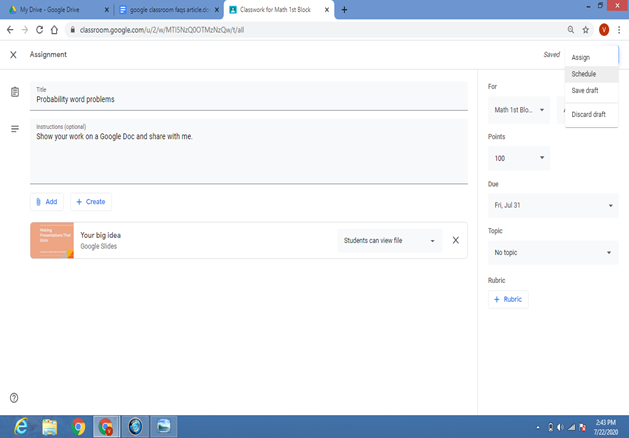
- Select the date and time in the pop-up window.
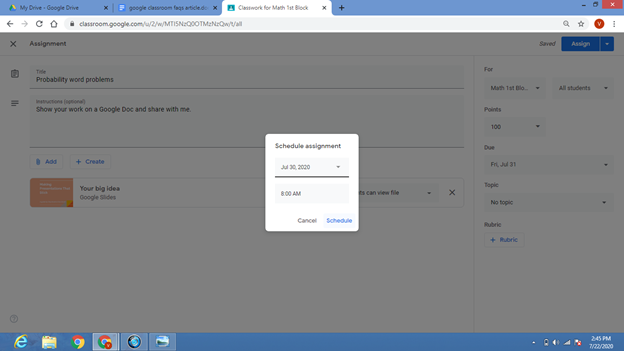
- Click ‘Schedule,’ and the assignment will be posted on the date and time of your choosing.
Remember that a post can not be scheduled for multiple classes. It must be done individually for each class.
How Do I Create Self-grading Quizzes in Google Forms?
You can create self-grading tests through Google Forms. It saves time, the students can see their test results right after they submit the quiz, and you can pre-record feedback for right or wrong answers.
Here is how you do it:
- Create a new Google Form.
- Click on the gear icon to open the Settings menu, choose the ‘Quizzes’ tab, and toggle ‘Make this a quiz.’
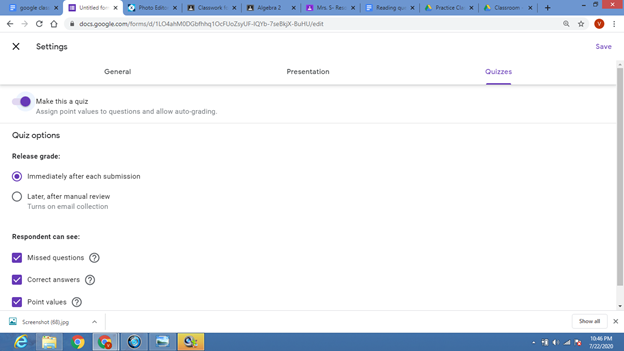
- In the options under ‘Release grade,’ select “Immediately after each submission.’
- Now go back to the Form and fill up the questionnaire with instructions, attachments, questions, and answer choices.
- You can include the answer for each question, the points for each right answer, and your feedback for right or wrong answers.
- You can double-check the Form by clicking on the ‘Preview’ (eye button) on the top right-hand corner of your screen. You may answer all the questions and check if everything is working as you wish.

- Click on the ‘Responses’ tab next to the ‘Questions’ tab, then toggle ‘Accepting responses’ and click on the ‘+’ button to create a spreadsheet to collect the responses.

- Now back in your Google Classroom, create a new post, and click the Google Drive button to insert the specific Google Form.

- Learners will have access to view the Form as an attachment to the original post.
How Can I Grade Assignments in Google Classroom?
Once their assignments are completed, learners can turn them in through Google Classroom, and you can assess them through the platform, thereby making the entire process paperless.
Here are the steps for doing it:
- Choose a Classroom, click the ‘Stream’ tab to see all the latest assignments or questions.

- Click on the assignment for which you want to view the list of learners who have submitted work.

- Click on the name of a particular student to expand their assignment.
- Open the attachment to view their submitted work.
- Review the assignment and add comments and feedback.
- Now go back to the ‘Learner Work’ menu.
- Set the total points (out of 100 points) that a student can possibly receive for completing their assignment.
- Enter the points earned by the learner.
- Select the learner, and click ‘Return’ to send back the graded assignment.
- On the confirmation pop-up, add private comments, if you must, and click ‘Return Assignment’ when you are done.
How Do You Invite Co-teachers to Google Classroom?
If you have a co-teacher working with the students in the Classroom, you can add them to your Google Classroom account. While you invite your co-educator, you can always control what they can and cannot do within your Google Classroom based on the default permission settings.
Here is how you do it:
- Open your Google Classroom window.
- Select the class where you want your co-educator to be added.
- Click the ‘People’ tab at the top of the screen.
- Click ‘Invite Teachers’ on the upper-right corner of the screen and type in the names or email addresses of the ‘co-teachers’ you would like to add.

- Once you are done, click ‘Invite,’ and an email will be set to inform the teachers that they have been invited to join your Google Classroom.

The co-teachers you have added will not have the same permissions as you, the Classroom owner. They can access all files in the classroom drive, post assignments, and materials, view who turned in classwork and assign grades. However, they cannot delete a class, remove, or mute you, the primary educator.
How Do I Communicate with Parents with Google Classroom?
As an educator, you have the option to keep the parents or guardians of your learners informed about their child’s progress. You can send them automated email summaries of details such as unfinished classwork, future projects, or class activities.
The guardian email summaries feature is turned off by default. Here’s how you can turn it on:
- Select a Class.
- Click on the Settings (gear) icon, and scroll down to the ‘General’ options.
- Toggle ‘Guardian summaries’ to turn it on.

Next, you have to invite the parents to your Google Classroom so the summaries can reach them. Go back to the ‘People’ tab. Here, you will find, next to your students’ names, the option to ‘Invite Parents.’ Click on it, enter the parents’ or guardians’ email addresses, and click ‘Invite.’
If you cannot invite guardians, you may need to resolve this issue with your school administrator.
How Do You Communicate With Students Using Comments in Google Classroom?
You can communicate with your students inside your Google Classroom in two main ways. These are- class comments and private comments.
Class comments: This is similar to comments made with your social media handle, where your comments will be visible to the entire class. Class comments appear in the ‘Stream’ tab, where both the educator and the learners can reply to comments.

So if a student has a question about the assignment, they can comment under the post, and the educator can reply with an explanation. Since all can view these Class comments, even other students can benefit from them.
You can even set who can comment on the posts. Google Classroom provides you with these three choices: Students can post and comment, Students can only comment, and Only teachers can post and comment. Change the settings as desired in the ‘General’ settings section by clicking on the Settings (gear) icon on the ‘Stream’ page. A drop-down menu below the ‘class code’ contains all three options. It is essential to instruct the students to post comments responsibly so as to create an environment open for discussions and conversations about the course. You can then let them retain their privileges to comment!
Private comments: These are helpful for one-to-one conversations between a student and a teacher. You can provide constructive criticism or praise to a student about an assignment without it being visible to other learners or appearing on the ‘Stream’ tab.
Students can add their private comments when they submit their assignments in the assignment turn-in pop-up. You can view these comments and reply to them from the ‘Grading’ section. These options encourage healthy and frequent communication between the teacher and student that is crucial for the teaching and learning process.

How Do I Send Students Emails in Google Classroom?
You can also communicate privately with a student via email through Google Classroom instead of a private comment. This feature allows you to explain your thoughts more exhaustively.
Here is how you do it:
- Select a Class.
- Click on the ‘People’ tab at the top of the page.
- Check the name of the learner(s) you would like to send an email to.
- Click on the ellipsis (three dots) button on the right corner of the name and select ‘Email student.’

- On the Gmail pop-up that appears, type your message and hit ‘Send.’
To benefit from this feature, you must be logged in to your Gmail account, and your students must have access to their email. So make sure these boxes are checked first.
How Does My Child Access Google Classroom?
The teacher does most of the work in setting up a Google Classroom. Once they set up the Classroom, they will provide a class code for your child to enter. The teacher can also send an invite via email. When your child has been granted access to the Classroom, they can join any time by merely going to classroom.google.com.
For students taking multiple subjects under different teachers, multiple Classrooms will appear on their dashboard. They have to select the Classroom that they want to enter from the dashboard. Once the student enters the class, they will find the following tabs at the screen’s top.
- Once a student logs in to the Classroom, they will see the Stream tab, showing the announcement page where the teachers post course-related content and other messages. They will also find an overview of the work they have been assigned to do or any other posts the teachers may include.

- Next to the Stream tab is the Classwork tab. It shows a full list of the assignments added by the teacher. A click on any assignment shows all details like due dates, resources required, and completion status. The student can also submit their finished assignments here, adding files, slideshows, or images as necessary.

- The last tab is the People tab, which shows all the students and teachers participating in the Classroom. Here, students can directly communicate with one another or with their educator via email.

How Do I Create a Class in Google Classroom?
Creating and developing a Classroom in Google Classroom is reasonably simple and can be achieved by following the steps below:
- Click on the + sign in the upper right-hand corner of your Google Classroom account. Select ‘Create class.’

- A ‘Create class’ pop-up will show up. Fill in the relevant information in concise and clear words. The Class name is mandatory, while the Section, Subject, and Room are optional. Once done, click ‘Create.’

- In the ‘People’ tab, click on the sign next to ‘Students’ to add your learners to the Classroom. You can add learners by entering their email addresses and adjust what permissions you want the learners to have regarding commenting and posting. If the class is large, this process is going to take quite some time. Alternatively, you can ask your students to join the class by entering the code you have provided them with. You will find the code at the bottom of the page.

- Open your ‘Stream’ tab to make any announcements to the class. You will be able to attach a file, a document from Google Drive, a YouTube video, or any other link to a resource.

- In the ‘Classwork’ tab, create an assignment for the learners enrolled in the class. Add in the title, the description, and instructions and give it a deadline for completion. Attach any resources you want the learners to refer to, and then click on ‘Assign.’

- Your class is now ready to go. The learners can now gain access to the class and work on their first assignment.
How Do I Monitor Student Assignments in Google Classroom?
Using Google Classroom makes grading assignments a seamless task, and the graded assignments reach students promptly. Here’s how you can grade and return assignments in Google Classroom:
- In your Google Classroom account, click on the ‘Stream’ tab. You will find ‘Upcoming Assignments,’ which lists all the assignments you have posted, on the page’s left corner. Click on one of those.

- This will take you to the learner work page. It shows you the learners’ status of assignment completion. An assignment is marked complete when a student submits their work in their Google Classroom account. This option automatically allows you to view the names of the students who have turned in their work. You can then reach out to those who haven’t submitted their work to ensure they do not fall behind academically.
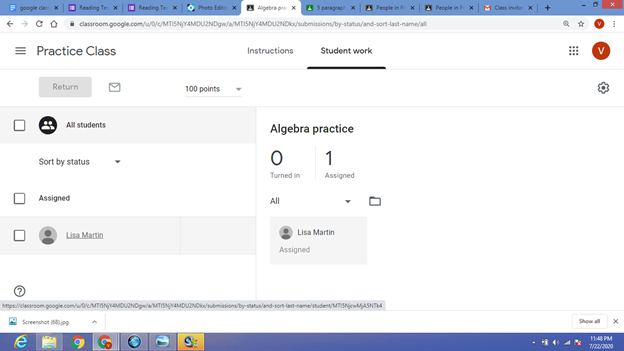
- Check the box next to the learner’s name. It allows you to email the learner(s) by clicking on the ‘envelope’ icon at the top of the screen. It’s better to send an email if you have more than a few questions or explanations to share.

- You can review the students’ work and assign them grades and points now. What was previously a tedious job done by hand now can be done by a simple click. Once a student has submitted their work, you can grade it and return it to them. The student will automatically see their grade once they log in to their Google Classroom account.
- Clicking on a student’s name will allow you to send them a private comment (including some constructive criticism), a request for altering something in the assignment or resubmission, or even some praise for their effort.

- Clicking on the folder at the top of the learner work page allows you to view all students’ work simultaneously. You will now have access to all the submitted assignments, and they will include the student’s names in the title, so you know who the work belongs to.
Why Should We Use Google Classroom?
One main reason to amalgamate Google Classroom into your actual Classroom is because of the highly engaging nature of the app. Children love working with technology. Combine it with a fast and paperless way to cover and exchange resources like Google Slide presentations with bright and colorful images, and the app is bound to increase students’ interest in learning. Besides, it much more fun for the educator to create interactive resources than filling out a boring worksheet!
Google Classroom is relatively easy to get the hang of once you use it a couple of times. Students are already very good with technology on their own. Just a few tutorials will have them ready to log in and get started on their assignments. They might even come up with new and creative ways to use the app to surprise the educator.
Another beneficial feature of Google Classroom is its organizational features. All work assigned or submitted is saved in Drive. No worries about lost homework or a massive stack of assignments to hand out. All work is online and safe.
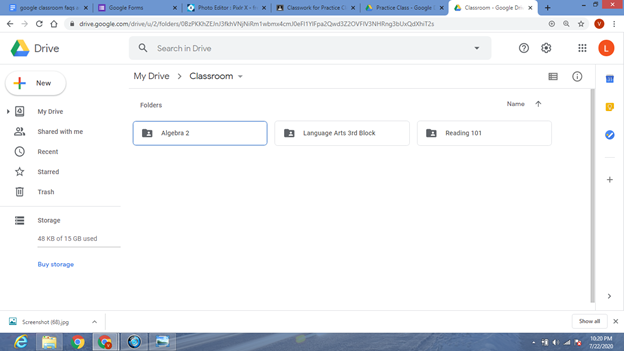
This feature also saves teachers a lot of time. All they have to do is share resources with their students through Google Classroom, and it is then available to the students to peruse at their own time. They can access any educational material they require to grasp a concept in their course fully.

We all know, no teacher likes grading assignments. The self-grading feature on Google Forms makes everything that much easier. It even gives you a spreadsheet of the students’ scores. With Google Classroom, you can create quizzes with multiple choice questions and input the correct answers. Once the student submits the test, their score is automatically shared with them and you. So, not only is it an incredible time-saver for the educator, but it also provides students with instant feedback.
This app allows an educator to better cater to a student based on their abilities. Learners can freely work at their own pace while having differentiated assignments to suit their needs. The teacher can assign assignments to specific students or modify assignments with additional resources to be submitted at a different due date.
Why is Google Classroom So Popular?
If you have been using paper for your resources and assignments, Google Classroom provides a user-friendly digital alternative. The app is intuitive and easy-to-use, and if you have been using paperless methods for learners before this, the Classroom will effortlessly integrate apps to make for an efficient workflow.
The app’s self-organizing feature is incredible as it puts all assignments in one safe place to be accessed whenever you want. No more losing assignments that turn up months after their due date! Students can log in to their Google Classroom account, and their projects will be waiting for them, especially with the handy auto-save feature of all Google apps. For an educator, this app is immensely flexible and time-saving. It streamlines the whole process of developing an assignment, copying, assigning, supervising, collecting, grading, recording grades, and returning the assignment with feedback into a few small tasks that can be accomplished by a few simple clicks. Every piece of work is saved and organized in a Google Drive folder with easy access.
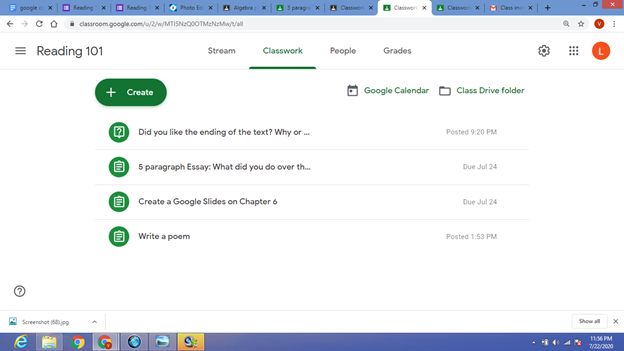
Google Classroom is a management app rather than a production app. It is user-friendly like all other Google apps, and if the students use other Google apps such as Docs or Spreadsheets, they will feel comfortable using Classroom. It merely requires you and your students to post information and locate them when necessary.
Google Classroom is designed to provide a healthy learning environment where ideas can flow freely, and discussions can be held easily. An educator can post a question on the ‘Stream’ page, and everyone in the Classroom can reply with their answers or link resources and share ideas with each other.
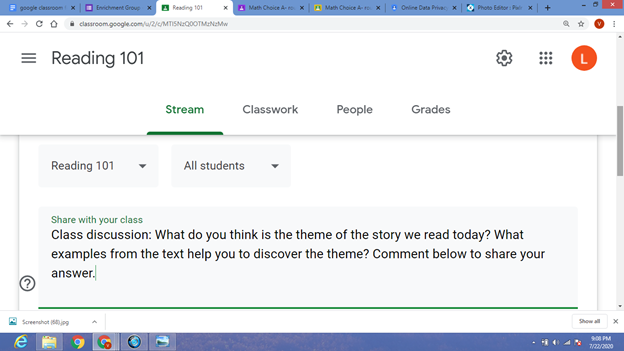
Due to its time-saving features, paperless platform, and ability to create engaging, interactive assignments, it is quickly becoming a popular learning management app used in many schools and educational institutions.
How Does Google Classroom Compare to Other Learning Management Systems?
The market for Learning Management Systems or LMS’s is already cutthroat. Many other LMSs have been here for a while, providing unique features and user-friendly tools. Google Classroom has many innovative features. But what makes it have the edge over other LMSs is its easy integration with Google’s other free services. This helps teachers to incorporate Google Docs, Sheets, Forms, or Slides into their assignments while also making sharing assignments with students more manageable.
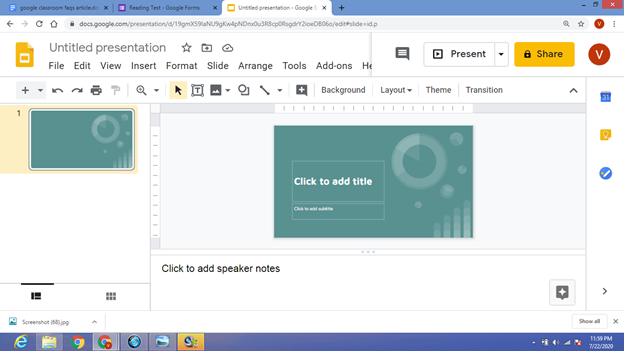
Another massive advantage of using Google Classroom is that it is created for easy collaboration or sharing. Learners can share their work and resources with their classmates and interact with them by sharing questions and tips. Educators can collaborate with each other and can assign tasks for group projects to specific groups of students. One-click is all that is required for a collaborative discussion.
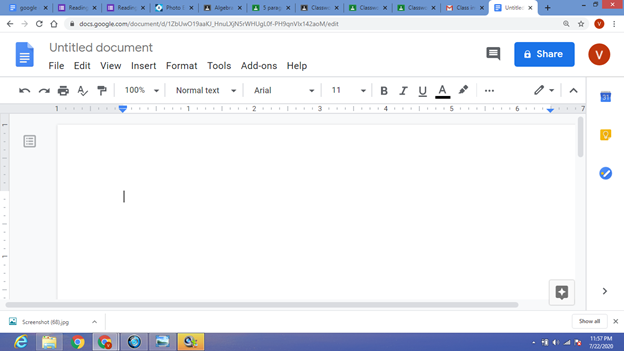
However, if you have grown used to other LMSs, you might not find certain perks that they have included over several years of modification. Some LMSs allow educators to create assignments right in the app or enable a seamless integration of non-Google apps for communication and sharing of relevant data.
What Types of Posts and Assignments Can You Make in Google Classroom?
Although you can post just about anything in Google Classroom, there are five main types of posts it allows you to create:
- Assignment: You can make a post that provides students with assignments and allows them to submit them. You can build assignments on any subject and have the students complete them in many different formats, such as a Google Slides presentation, or fill in data on a Google sheets form. Based on the content you want to cover, you have endless ways of creating assignments that meet each student’s needs and abilities.
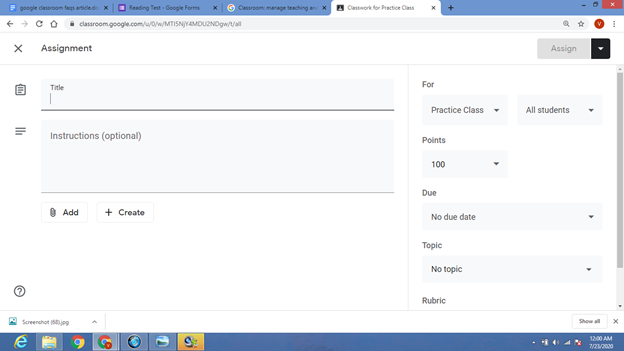
- Quiz Assignment: You can post a Google Form questionnaire or quiz in the Classroom. You can make it multiple choice or short answer, input the correct answers to have it automatically graded. Students can immediately see their grades once they submit the quiz. It provides immediate feedback and saves time.
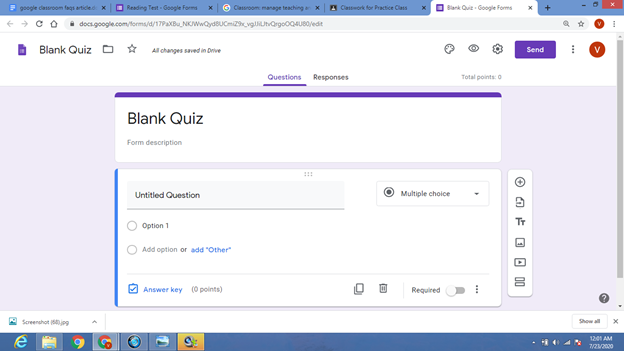
- Question: You can post a question for your students to reply to. It can be a question that the students can respond to with short answers. It can also be a question inquiring about the best time to hold a video conference, or you can ask for student feedback about coursework.

- Material: You can post resources for coursework or assignments, which can be in the form of an article (through Drive), a link to a piece of information, pictures or slides, even a YouTube video. Any kind of educational content, posters, or study guides can be posted.
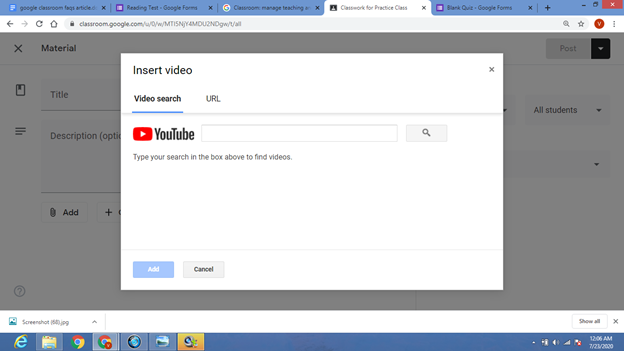
- Post to the Stream: An announcement or link posted on the Stream homepage will be the first thing your students will see when they login into their Google Classroom account. These posts are great if you want to share important messages. You can even choose which students get to see your posts if you only want to reach specific students.
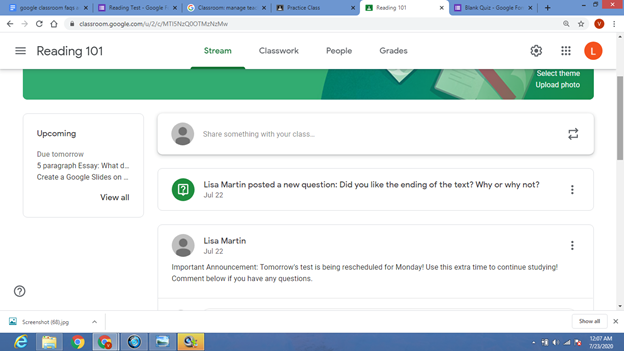
When you create a post, you can always link documents from your Google Drive, images, or videos. Many apps can integrate well with Google Classroom, so you can always share content with ease.
In Google Classroom, What Are the Essential Parts of an Assignment Post?
Educators have several options for personalizing assignments for their students with the help of an assignment post,
- Title: You type in the title of the assignment here. The title of a project always has to be concise and easy to understand. Never repeat a title, or it might confuse your students.
- Instructions: Instructions are not mandatory. You can add pieces of information or notes you want your students to remember while attempting the assignment. You can add tips and tricks, or reminders, or a warning statement.
- Add: This is the space where you link resources that your students will need to understand and complete the assignment correctly. You can share a document from Drive, a file, or a video. You can make the learning process a lot more enriching and interactive in this way.
- Develop: This is where you can create a new Doc, Slide, Sheet, Drawing, or Form. Create the perfect assignment, and then it can be easily uploaded as a new assignment.
- For: A assignment is usually automatically posted in the Google Classroom you are working on. But by using this drop-down menu, you can choose a single assignment to be posted to multiple Classrooms. You can also select a particular project to only be accessible by a specific group of students or even a single student.
- Points: By default, the app assigns 100 points to an assignment, but you can alter it or leave it ungraded.
- Due Date: You can choose a due date for the assignment to be submitted by the learner. A deadline helps students to stay focused and motivated. If you want your students to have sufficient time to finish the assigned work without the added pressure of a deadline, you can select the ‘no due date’ option.
- Topics: If you want to separate your assignments by subject, you can assign them under a particular topic. It helps to keep your projects even more organized. However, it is an optional setting, so you can always choose ‘no topic.’
- Rubric: You can create a rubric for your assignments within Google Classroom or upload your own. Students can self-assess their work through the provided rubric.
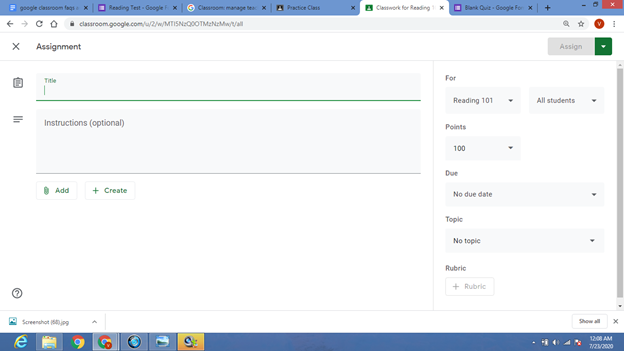
You can post your final assignment by clicking on ‘Assign’ on the upper right-hand corner of the page. If you have several projects ready to go but do not want to post them all at once, you can schedule your posts. This can be done by clicking on the downward pointing arrow next to ‘Assign’ and then selecting ‘Schedule.’ You will be asked to set in a date and time for your assignments to be posted, and you don’t have to worry about posting it on time after that.
How Do I Delete a Google Classroom I Am No Longer Using or Made by Mistake?
You can archive a Class when you are done with it and reuse the posts at a later date if you want. However, if you do want to delete a class, here are the steps you need to follow:
- To delete a class, the first step is to archive it. In the Classes homepage, hover the cursor over the class you want to delete and click on the ellipsis (three dots) button and select ‘Archive’ from the drop-down menu.
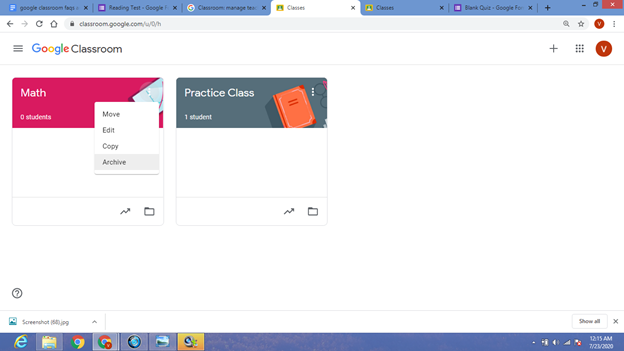
- A confirmation pop-up will appear. Click ‘Archive.’
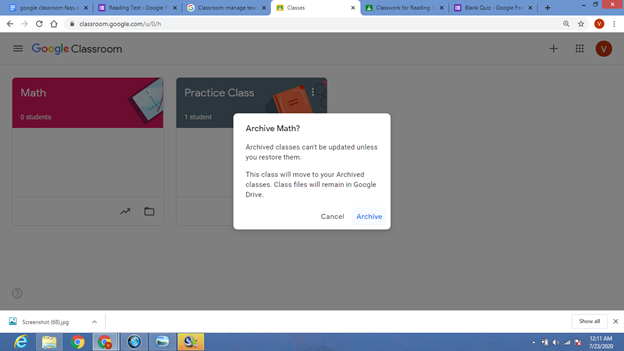
- Then, on the menu on the left corner of the homepage, select ‘Archived classes.’
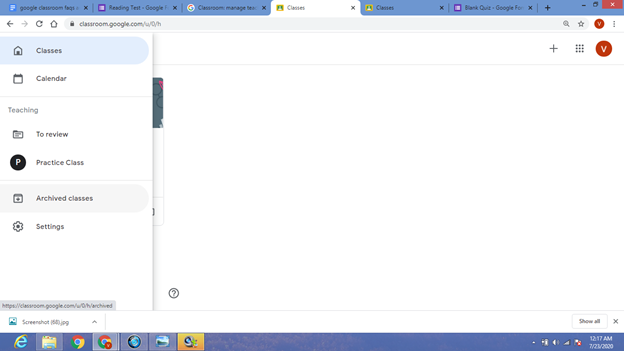
- You will find the class you just archived. Click on the ellipses (three dots) on the upper right-hand corner of the class and select ‘Delete.’
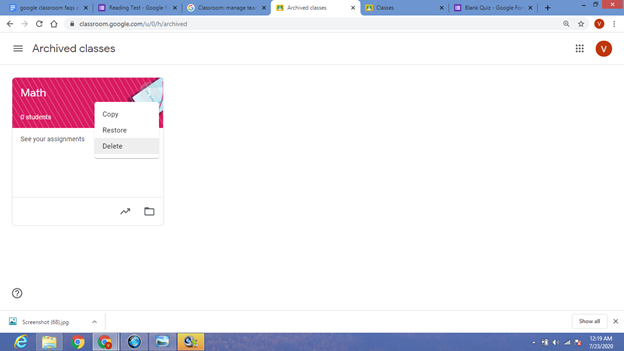
- A confirmation pop-up will appear, asking you if you are sure to delete the class. Click ‘Delete’ to delete your class permanently.
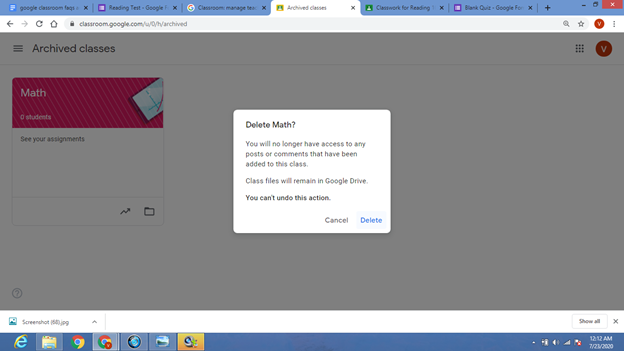
Where Do I Find the Class Drive Folder?
The shared Drive Folder located in your Google Drive can be accessed in two ways. First, through your Google Classroom account, and second, using your Google Drive account. This folder includes every assignment you have created for the class, all the resources you have shared, any materials you may have uploaded, and all the work turned in by your students.
To access this folder using the first method, go to the ‘Classwork’ tab in your Google Classroom account. You will find it in the upper right corner next to the folder icon titled ‘Class Drive Folder.’
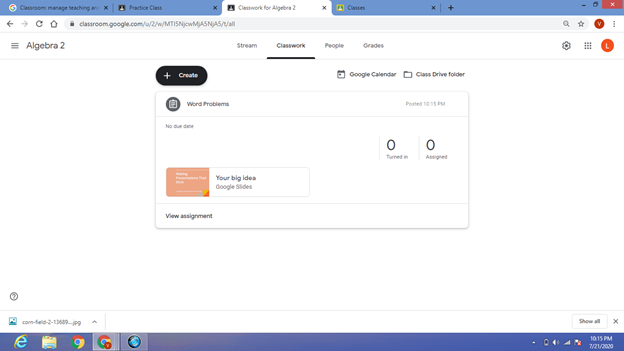
To access the folder from your Google Drive, login to your Drive by going to drive.google.com. Once the page opens, click on ‘My Drive’ on the left-hand side.
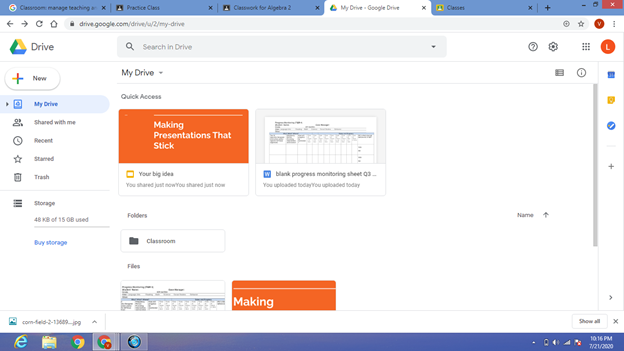
You will find a section named ‘Folders’ where you will see a folder titled ‘Classroom.’ Clicking on this will take you to all the drive folders for each of your Google Classrooms. The title of each drive folder will be the same as that of the corresponding Classroom. Here is an example:
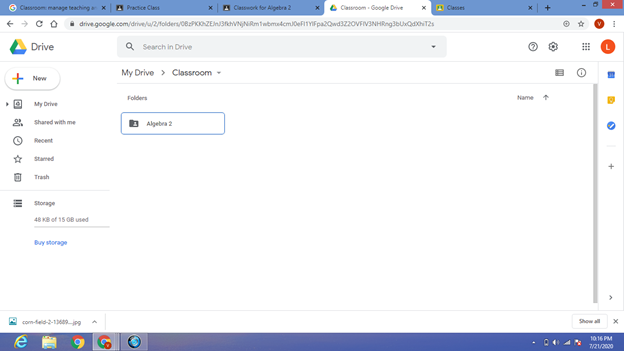
How Do I Personalize My Google Classroom Homepage?
By default, Google Classroom will put a random image as the background of your Classroom. But you can always change it based on the subject, theme, or your personality. The app allows you to pick a theme from a menu of choices provided by Google, which include the categories: General, English & History, Math & Science, Arts, Sports, or Other. Each category offers many colorful and inventive pictures to pick from.
To choose a theme for your Classroom, go to the homepage, and you will see a colorful rectangular box that mentions the class title and class code. Click on ‘Select theme’ on the bottom right corner to pull up your options.
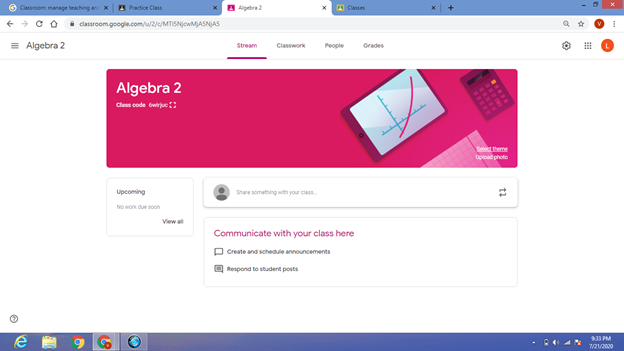
Choose the theme you like best and click ‘Select class theme’ on the bottom left corner. The new theme will now be updated on the homepage.
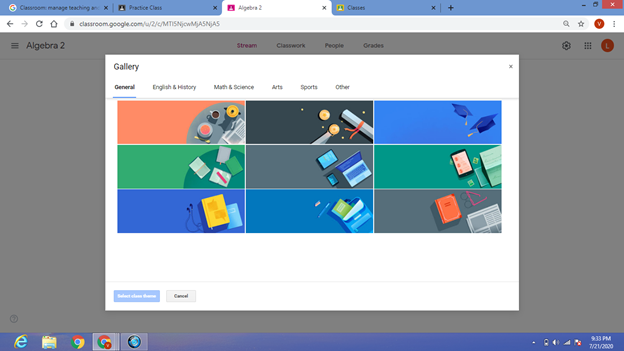
In case you do not like any of the theme choices, you can drag and drop an image or upload it from your computer. You can choose to upload a personal photo or one downloaded from the internet. To select this option, go to the Classroom homepage and click on ‘Upload photo’ in the bottom right corner of the colorful rectangle showing the class code.
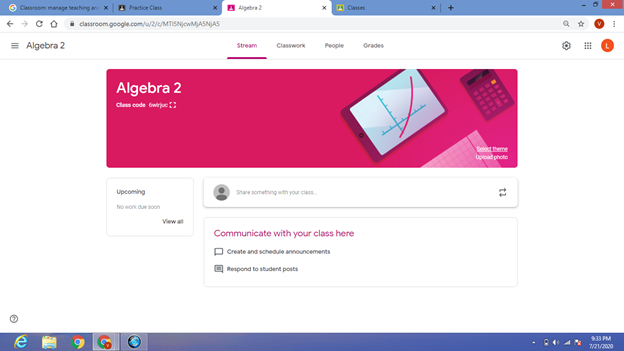
Click on it, and the screen below will appear:
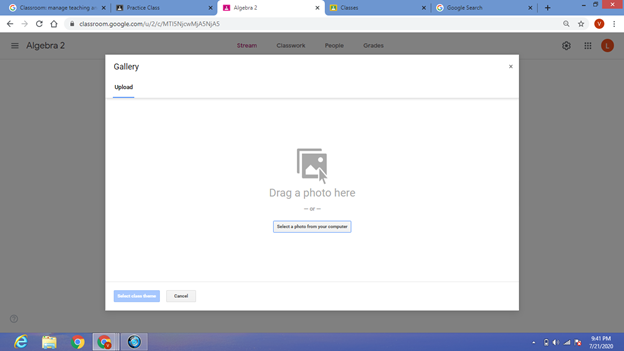
You can drag and release a photo it, or click on ‘Select a photo from your computer.’ A menu showing your files will appear.
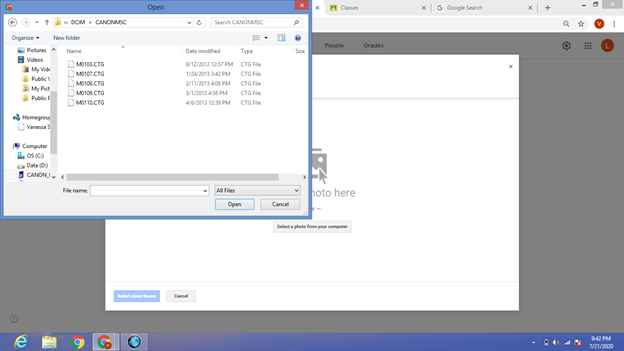
Select the image file that you want to upload and click ‘Open.’
It will upload the image you selected:
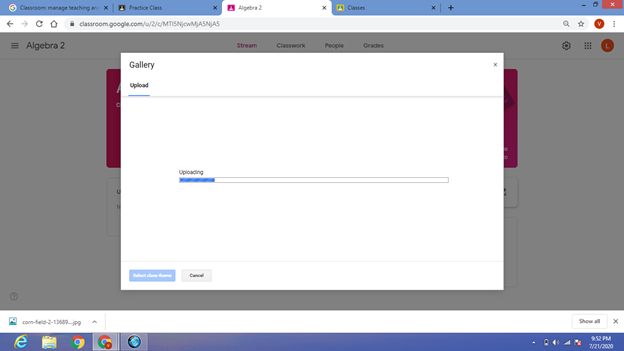
Once it is uploaded, you can crop it as you desire. Once you are happy with the way it looks, click ‘Select class theme’ on the bottom left corner. The image will be uploaded to the main page.
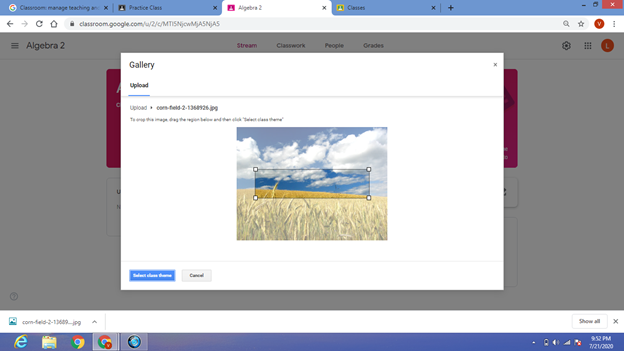
How Do I Save an Assignment as a Draft and Finish it Later?
One of the handiest features of Google apps is their auto-save feature. You no longer lose work if you forget to save it or your computer crashes mid-work. Google Classroom also has the same auto-save feature.
You can save an unfinished assignment as a draft by merely clicking the drop-down arrow next to the ‘Assign’ tab and selecting ‘Save as draft.’ However, it is unnecessary to log off in the middle of creating an assignment, as it will automatically be saved as a draft. You can come back and finish it later at any time.
The following is an example of an assignment that has not been posted:
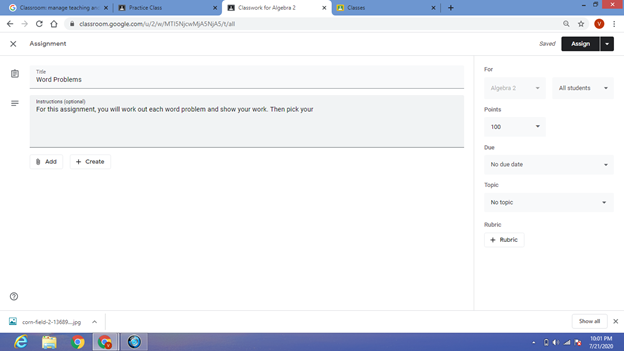
The ‘X’ next to ‘Assignment’ allows you to exit out of the assignment you are working on and come back to the ‘Classwork’ tab. You can see it being saved as a draft here.
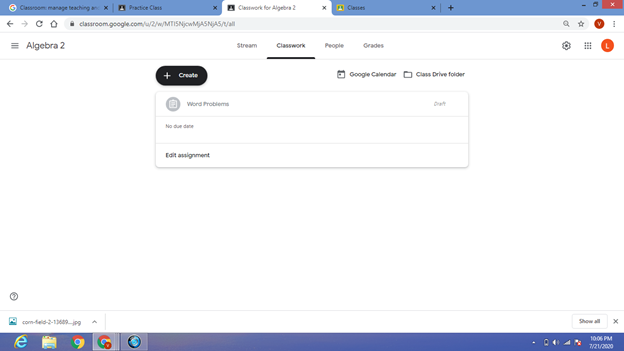
Your unfinished assignment will still be in the drafts section even after you have logged out. You can come back at your leisure and click ‘Edit assignment’ to finish creating the assignment.
If you want to delete the draft, click on the ellipsis (three dots) button next to ‘Draft’ and select ‘Delete.’ Your draft assignment will be deleted.
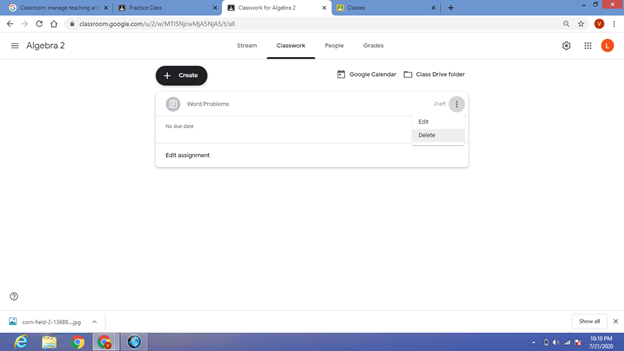
How Do I Create a Spreadsheet of the Assignments and Grades From My Google Classroom?
Under the ‘Grades’ tab of your Google Classroom, you will find an easy to read and well-kept digital grade book with all the assignment titles along with their due dates and the grades assigned to each student. The ‘class average’ feature takes all the grades for a particular assignment and churns out the class average for that assignment. If you want to view the grades in the form of a spreadsheet, Google Classroom allows you to convert the digital grade book into a Google Sheets file. Here are the steps:
- Click on the ‘Grades’ tab to view the digital grade book.
- Click on an assignment title, and then go to the Settings (gear) icon in the right-hand corner of the page. Select ‘Copy all grades to Google Sheets.’
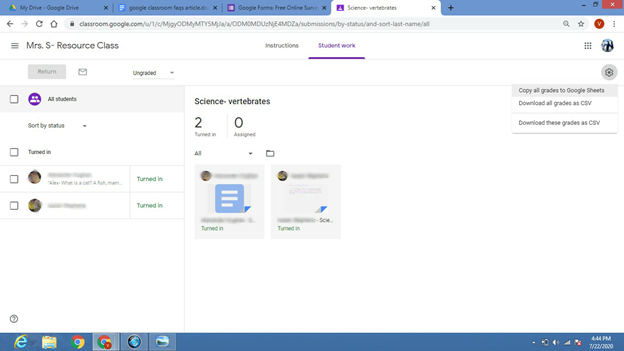
- A Google Sheet will automatically be generated for you, using your Google Classroom grade book’s data. You can view it on your screen as it opens up automatically.
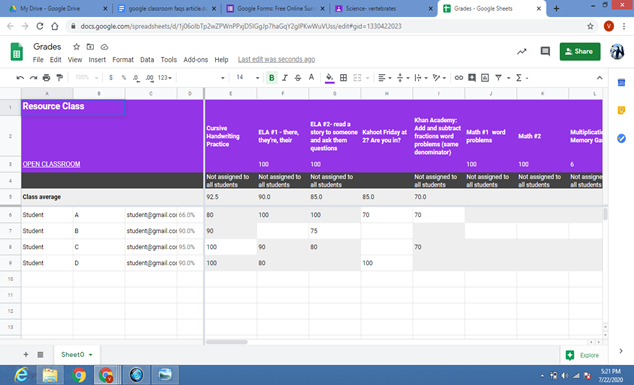
Why would I want to create a spreadsheet?
- A spreadsheet allows you to have a printable record of the grades you handed out.
- You can share the spreadsheet with the school administration to assess and discuss student progress in the class.
- You can make a copy with only one student’s grade information to share it with their parents during a conference.
- You can add additional student info to the spreadsheet for a more comprehensive file.
- The spreadsheet allows you to calculate the class grade average automatically.
Concluding Thoughts
We hope this guide answers all the frequently asked questions regarding Google Classroom.
How do you think we did? Did we miss any questions? We hope the guide helps you understand Google Classrooms’ inner workings and endless features.


